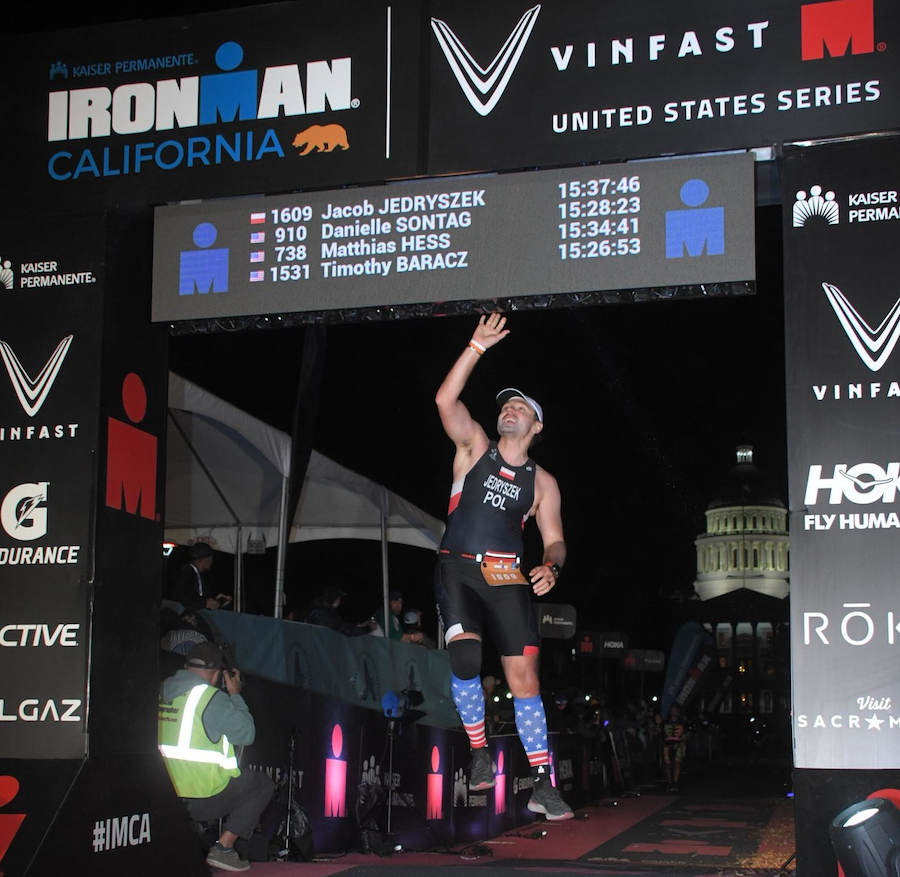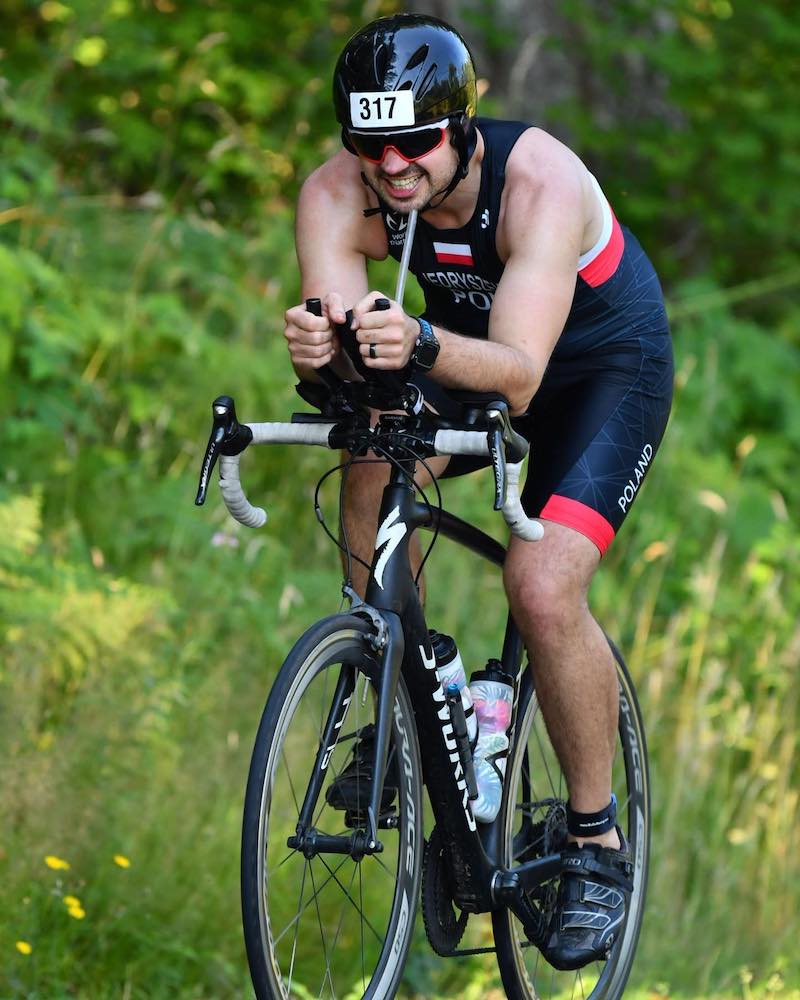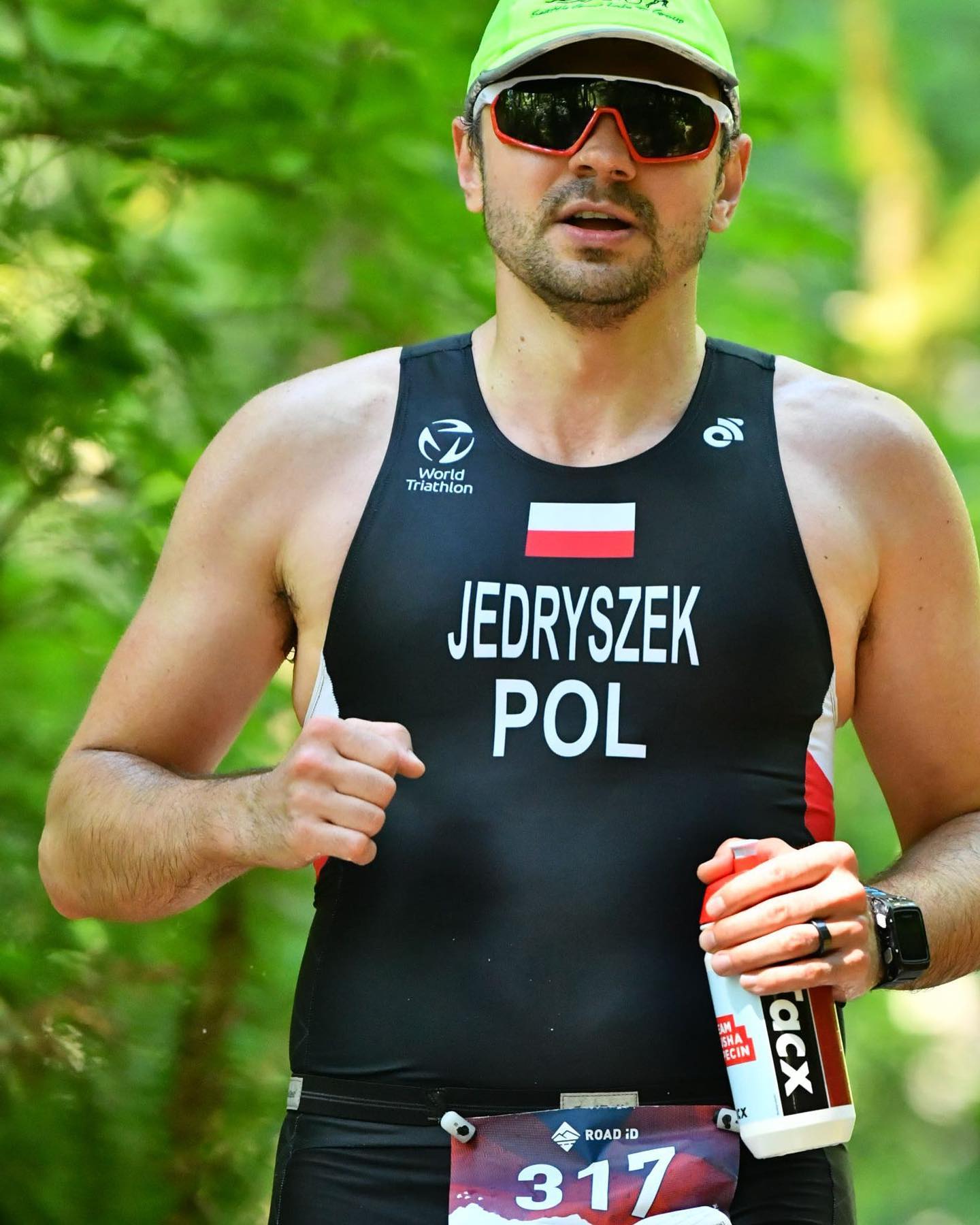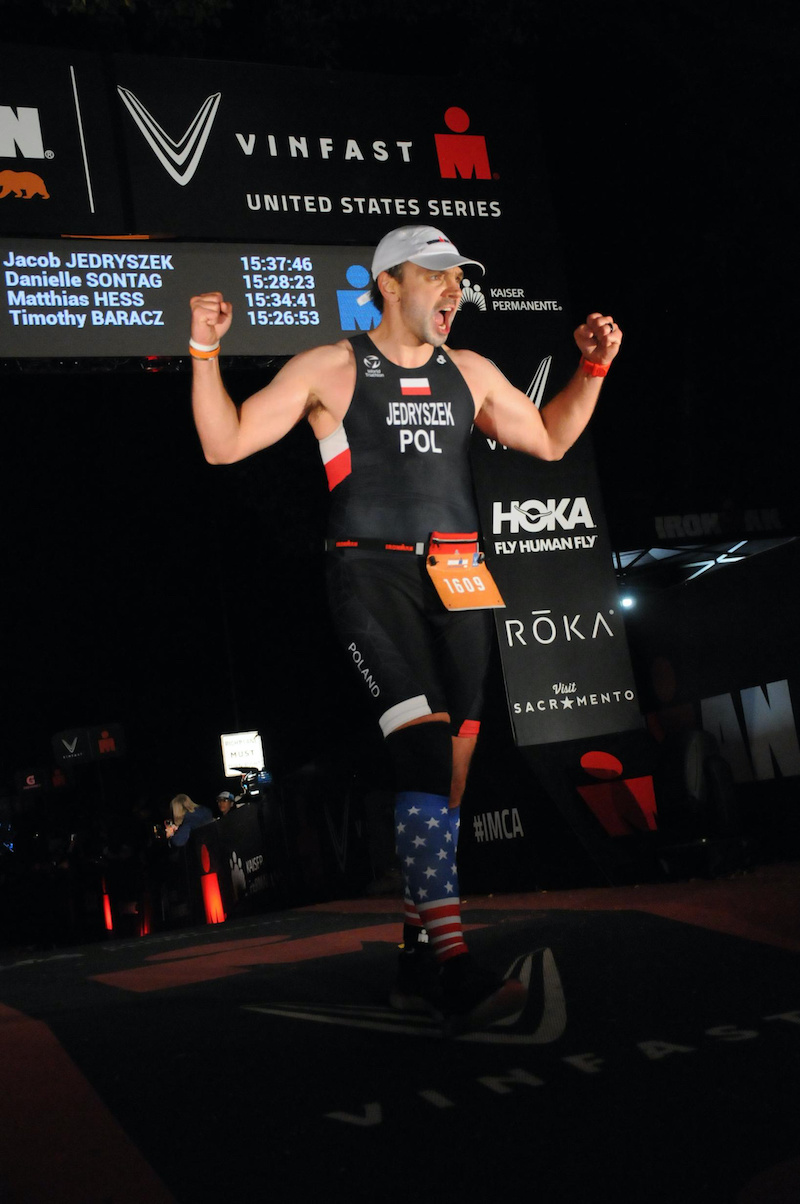I am an Ironman!

The Ironman triathlon is 2.4 mile swim, 112 mile bike and 26.2 mile run (marathon). You have 17 hours to finish in order to become an Ironman.
How I got into triathlons
I’ve been doing triathlons for over 5 years now. Mostly Sprint and Olympic distances. I also did a few half Ironman distance races (AKA Ironman 70.3).
This is what each distance contains:
- Sprint: 750m swim + 20k bike + 5k run
- Olympic: 1.5k swim + 40k bike + 10k run
- Half Ironman: 1.2 mile swim + 56 mile bike + 13.1 mile run (half marathon) - the total distance is 70.3 miles, therefore it’s also called Ironman 70.3.
I love biking since I was a kid. I decided to try triathlons when I was in college. Unfortunately, it took me a while to do my first triathlon, because of knee injury. Coming back to sports after that took over 1 year.
The first triathlon, I’ve ever done was indoor triathlon i55: 10 mins of swimming + 30 mins of biking + 15 mins of running. The final result was based on the total distance covered. As most beginners, I pushed too hard on bike, and was barely able to run for 15 minutes. Despite that, I was hooked, and soon after that I signed up for my very first sprint triathlon.
The first sprint triathlon I signed up for (Kirkland Triathlon) didn’t happen, because of the water quality at Juanita Beach in Kirkland. A few days before the race, they changed triathlon to run-bike-run, which was ultimately a duathlon. I still got triathlon finisher medal as they had them made before finding out about the water quality issue.
Despite all the obstacles, I decided to keep going. I kinda did sprint, so I went ahead and signed up for an Olympic Triathlon next year. It was Troika Triathlon in Spokane, WA. It was almost my first, legit triathlon. Almost, because the swim was cut short due to the weather issues, and bike distance was extended to compensate for shorter swim. I really enjoyed the challenge, and decided to take it to the next level. I did one more Olympic tri and entered the serious triathlon World by doing half-Ironman distance race. It was actually much easier than I thought, and I was thinking that maybe I would’ve been able to pull a full distance that day!

While training for half-Ironman, I learned that you cannot live life like you use to and just throw trainings in the spare time. You need to add time for rest, and take care of the nutrition. I learned that hard way. One week before the half-Ironman I was soo tired that I spent entire weekend in bed. I wasn’t sick. No cold, or sore throat. I was just exhausted.
Over years I did a few more sprints, olympics and one more Ironman 70.3 triathlon. While olympic distance races went well, the half-Ironman was a challenge. I was dealing with foot injury, and decided to just run less during the training for the race. This, didn’t ended up well. After the race, I messed up my foot so bad that I was barely able to walk. Fortunately, after a week or so I was fine. At that time I didn’t even stretch before and after workouts! Still had a lot to learn.
After the Ironman 70.3, which ended up with injury I concluded that races above Olympic distance are not healthy. They require more time to train that you need to stay healthy. There is too much strain on your body. Often resulting in injuries. There is also need to spend more time that I would like to in training. You want to go hiking this weekend? No, I need to do my planned swim. If I won’t my training plan will get screw up, and I’ll have to readjust it…and I won’t be prepared for the race as good as if I’ve done the planned session. So I sticked with Sprints and Olympics for a while.

Ironman journey
I knew that at some point in my life I wanted to finish the full distance Ironman triathlon. I was delaying it, because I knew that it would require significant time commitment. Not only for the time to train, but also for time to rest. When COViD happened, and put a pause to my favorite sport, I realized (again) that life is short and I shouldn’t postpone things. In 2020, when all races were cancelled, I did Sprint and Olympic triathlon with friends. We just swam, biked and run on our own. It was fun, but not as fun as real races.
When, in 2021 triathlons started happening again, I decided to do Ironman 70.3 Oregon. I was hungry. As running was my weakest discipline, because of the knee injuries, I decided to do half Marathon earlier that year. My thinking was: if I finish half marathon, I can do half Ironman. Swimming and biking wasn’t a problem for me. I did half marathon, followed by Olympic triathlon, and finished half Ironman without problems. Injury free! After the race a thought came to my mind: why not keep training and do a full Ironman this year? There was Ironman California, just 3 months away. This would give me enough time to build up from half to full Ironman. After discussing it with my wife, I signed up!
Training
I followed My First Ironman Training Plan. I made one adjustment: I was doing only 1 swim per week instead of 2. Why? Swimming takes a lot of time! Not swimming itself, but before and after. Driving to the pool (or lake), changing, driving back, etc. It’s much more time consuming than biking and running. Additionally, the Ironman California has down river swim, which makes it much easier. I decided to prioritize biking and running.
I maintained a Google Spreadsheet where I tracked all my workouts. I used green for workouts I did as planned (at least 80% or more of planned distance), yellow for workouts that were cut short (below 80%), and red for workouts I skipped. Marking workouts as done (green) was one of the best parts of my day.

Half way through my training I decided to do a quick consult with a coach. This made me to realize how much I didn’t know, and how much more I could’ve learn. I recommend anyone who want to attempt an Ironman to get a coach FROM THE BEGINNING!!! It will make your training more efficient, more enjoyable and less stressful. Is that enough? Am I doing it right? Isn’t that too much if I just want to finish? Coach, who has already done Ironman and trained others, can help to answer these questions. Thanks to my coach I realized that I won’t be able to run the marathon during Ironman. Together with other 80% of athleets. Only pros and top age-groupers run entire marathon. Most of people run/walk or just walk! I developed run/walk strategy that made my running more efficient: 0.3mi run / 0.1mi walk.
Life
Training for Ironman is not only about making time for training, but also about making more time for resting! I underestimated how much more time I would need for rest. Especially, during the weekends after long workouts. I just wanted to lay down in bed and watch TV…
Sometimes, easy thing like attending friend’s baby shower at 2PM on Saturday or joining friends to watch the new James Bond movie in the cinema that my friend rented was impossible. I couldn’t do baby shower because that day I had to ride 100 miles. For me that was ~8h. I would have to start at ~5AM, and shower/stretch/drive to baby shower in 1h. Not ideal. Especially taking into account that sunrise at the time was after 7AM. When planning to watch the new Bond movie with friends at 1PM, I had only 90mins run planned for that day. However, I had to change that plan, and I had to run 16 miles instead, which took me almost 4 hours. I planned to start at 8AM, but my body said no to 6AM wake up to eat ~2h before the run. I ended up starting after 9AM, and finished around 1PM. I skipped the movie. The Ironman dream was more important.
When reading this you probably think: couldn’t you just move that workout to different day or do it after the movie? Well, it’s not that easy. Doing it after the movie would require me to start around 5PM at best. Finishing long run at 9PM is not great. Moving to another day? It’s not easy to ensure that you do enough of swimming, biking and running even when everything goes according to the plan. Trying to move things around when you have full-time job, especially closer to race, is hard. Of course you can do it, but…you would be less prepared. You don’t want to DNF (Did Not Finish), because you decided to watch a movie instead of train, right?
The weather is another component that comes to play. The rain and cold can mess up your plans for good. I was actually pretty fortunate, taking into account I live in Seattle. Weather here, in September/October (peak training months), can be not the best. I had to shuffle workouts a bit, do some Zwift biking instead of running outside, and replace Open Water Swims with pool. The most important long runs and long bike rides I was able to do outdoor! Yay! I’ve seen other athleetes who had to do long 4h+ rides with trainer…I would’ve hate that.
Challenges
On top of already mentioned time-management issues and weather, you may also run into another very common challenge: injuries. This happened to me ~4-5 weeks before the race. My knee didn’t handle training load well. I also messed up by forgetting a knee brace that I usually wear for one of my long runs.
Many people quit at that point. I decided to do whatever it takes. I wanted to become Ironman. I didn’t want to postpone the dream. Especially, because I already put a lot of time and effort into this. Countless PT sessions, stretching, messages and hours of exercises at home on top of my workouts helped to alleviate the issue. I was still not very confident that I will be able to finish the race.
I did whatever I could, overcame all the obstacles: time management, sacrificing social life, and managing injury. Unfortunately, I couldn’t overcome the final obstacle. The race was cancelled because of Bomb Cyclone! They announced it at the race morning when I was putting my wetsuit on. It was the right decision. That day winds were 30-40mph, and it was raining. The day after, there were fallen trees on the bike course, and run course was flooded.
I was devastated. All sacrifices and hard work for nothing. I tried to look at the bright side though. I decided to properly recover from injuries, and attempt it again next year!
Recovery
When Ironman got cancelled I jumped straight into Physical Therapy. Dan Benson from ForeFront PT is the best specialist I’ve ever worked with. Strongly recommend! He not only helped me to recover, but also gave me some tips that helped to improve my running. It took over 4 months from the time I started regular PT exercises until I could finally run. I was doing sets of exercises, which take 30 mins or more every other day. I hated it! I was doing it only because of my dream: becoming an Ironman. There is nothing fun about PT exercises like hip rotations, penguin walks with band, side squats or speed skitters. I was very happy that I was able to go back to running. I strengthened my hip muscles, and actually started running properly. Per Dan’s advice I also tried to keep 175 steps per minute cadence, which is not easy! I was usually below 150 spm! Everytime when I was hurting, increasing cadence seemed to fix it. That was a silver bullet. After 4 months I could run, and I did 5k race that went smooth.
Smarter Training
Thanks to the experience from the previous year, I knew better how to manage my time during the training. No social life for 3 months, with 1 exception for a party in 1 weekend. No international travel during that time neither. I really spent 3 months focused on the race. My life was: work, training, rest. Not much room for anything else. I sometimes work 50-60h/week, and it was hard not only for me but also for my wife. We were both commited though, as we both knew it would be just one and done. I am very grateful for her support. Without that becoming Ironman wouldn’t be possible.
In my second attempt, I prepared better in all disciplines. I followed the same My First Ironman Training Plan. I still swam only once per week. This time I modified long runs to be distance based building up to 16 miles as longest run per my coach recommendation.
I vastly improved nutrition, both during and after training. 60g+ of carbs per hour during, and protein shake after workouts longer than 1h.
I showed up on the start line stronger than year before and injury free.
Successful race
My goal for the race was to finish. I estimated that in the best case scenario I can do it in about 14 hours, but realistically closer to 16. Again, the time limit is 17 hours. If you finish after 17 hours and 1 second you are NOT Ironman.
My pacing plan:
- swim: treat it as a warm up; swim at good pace, but don’t push
- bike: 80-90 rpm, HR below 144 bpm
- run: walk first 10 minutes, then run 0.3 mile / walk 0.1 mile, walk through every aid station
My nutrition plan:
- bike: during hours 1,3,5, and 6/7 - drink tailwind+gatorade mix (40-80g carbs per hour), in hours 2,4,6 - eat 1x honey stinger, 1x gel, 1x cliff block
- run: 1 gel every 15 mins, tailwind+gatorade on the half way point (special needs bag)
There were some challenges during, and before, the race that I didn’t anticipated. The transition was setup at the Stadium in Sacramento, CA. Getting in and out required a lot of walking. Before getting to water I walked 5000 steps! I also spent 1 hour in line to the shuttle, which was taking athleetes from the transition zone to swim start. However, after that the Lose yourself at the swim start, when I was entering the water, gave me good kick, and swim went great. It was very enjoyable experience. After it, another challenge: I had to run barefoot on concrete for 1 mile from swim exit to transition. I was worried that I could get injuried, and the race will be over. I took it very easy, walked parts of it, and made it to bike.
The 112 miles bike ride was not easy. I experienced the strongest winds I’ve ever biked with: 20-30mph! It was worse than biking in Kona, which is famous for brutal winds. I biked there year before. Bike course had two out and back loops (56 miles each). In some parts of the course I was getting tail wind, but other parts had head wind, and the worst possible: cross winds. I had to hold on to my aero bars and be focused every single second to don’t crash. It was very energy and mentaly draining. A few athleetes ended their race by crashing on the bike due to the wind. The last few miles were especially tough. It was against the wind, and wind was getting stronger later in the day. It was windy utill the very last turn into the transition!
When I got off the bike it was hard to walk. I was asking myself: “How am I gonna run a marathon now?”. I thought it was impossible, but I was trying not to think too much about it. Instead, I was focusing on executing my race plan. I took my time during the transition, changed to running gear, and walked for the first 10 minutes. After that, I started my run/walk strategy 0.3mi run / 0.1mi walk. I was also walking through aid stations, sometimes stopping for bathroom breaks.
First 9 miles went pretty well. After that, I experienced what Ironman athleetes call the dark moment. It was literally dark. We entered the park after sunset, and there was no lights there. Sometimes, total darkness. Thankfully to Ironman race organizers, there were providing head lamps for athleetes. However, even with the head lamp it was dark…
The miles were passing slowly and I was getting weaker. I had my rocket fuel mix (tailwind+gatorade) at run special needs bag, which was at mile 10.5. I drank almost entire bottle. After that I felt like puking for next 30-45 mins. I knew however, that I would be better off not feeling great than bonking.
Sometimes, I was wondering where is the next mile marker. A few times I thought that maybe I missed it, and the next one would be the following mile. Only to find a few minutes later that I just got to the one that I thought I passed…
The park section was out and back. After making the u-turn at mile 14.5 I started seeing the path to victory (AKA finish). It was more and more painful though. I started calculating how fast I need to run/walk, and it looked good. I even decided to walk 1 mile to see how much faster I am running than walking. It wasn’t much. Less than 5 minutes per mile! However, at that point it was more painful to walk than run!
In the last 10 miles I switched from eating gels to pretzels, chips and coca cola. It was great! Change from sugar to savory did magic. It was actually getting down easier than gels! That gave me a boost.
When I finally got to mile 20, one volounteer said that it’s only 10k to finish. 6.2 miles is 10k! This gave me another power boost. From that point I threw my strategy out of the window and just went on. I walked some parts of last 10k, but last 5k was my fastest split, and last mile was my fastest mile!

I finished in 15 hours and 17 minutes. A little below 16h I was targeting, but way above assummed best case scenario of 14h. The winds and long transitions prevented that. None of this matters now. I am an Ironman!
Crossing the finish line was awesome! I wish it lasted longer than a few seconds.
Reflection and Lessons Learned
If I was about to do it again, there are a few things I would’ve done differently.
- I would probably cap my runs by time as recommended in My First Ironman Training Plan, and for the longest run just do 16 miles instead of recommended 20.
- I would still do 1 swim per week. Even if it wasn’t down river swim, I would’ve swam 2.4 miles without issues.
- I would cut my dose of carbs from tailwind by half. Instead of 80g from tailwind I would get 40g, and try to get another 20-30g from gels or gatorade.
- I would put gatorade flavor I like in the bike special needs bag. The orange gatorade endurance provided on the course was awful. I couldn’t drink it, which forced me to switch to water. This resulted in less electrolytes.
- I would start eating chips/pretzels with coca cola earlier during the run. Probably after 5-6 miles.
- I would definitely get chicken broth whenever it was available. They were offering it when I was on the way out (about mile 11) and I was planning to get it on my way back…but when I was coming back they ran out.
Things besides training that helped me a lot:
- Stretching after every training.
- PT combined with strength exercises 1-2 times per week
- Making time for rest. Not planning anything after long bike rides and long runs on the weekends. It’s hard…but it helps a lot!
- Support from your partner, and understanding that 3 months before the race (or maybe even more) would be dedicated for Ironman. Not much time for travel or social life.
As I mentioned before, training for Ironman is much more than just putting hours of training. You need to be smart at handling unexpected life events, managing your life well to don’t get sick and most importantly knowing when to stop pushing to don’t end up with injury. Especially during the run. This is where majority (if not all) of athleetes get injuries.
Proper diet and enough amount of sleep is crucial. Otherwise training won’t be effective. In Fast-Track Triathlete Matt Dixon recommends to do not bother with training if you are not well rested as it will have the opposite effect.
Although Ironman challenge was a great journey, I am looking forward to go back to Sprint and Olympic distance races.
Maybe I’ll do Ironman in Kona after I retire ;)
Call to action!
It’s recommended that all of us do 30 mins of exercise per day. This is actually enough to train for both Sprint and Olympic distance triathlon!
If you do 2x30 mins run + 1x30 mins swim + 2x1h bike it would be more than enough to finish sprint triathlon! That’s total of 3.5h per week, which is 30 minutes per day.
For Olympic: 2x30 mins run + 1x30 mins swim + 1x brick (1h45m bike + 15m run) + optional 1x30-60mins run
That’s it! 4 times per week. 30mins/day average!
If you are interested in triathlon I recommend to join local triathlon club. For Sprint and Olympic distance races I recommend to use free training plans from Phil Mosley. To learn more about triathlon: Your First Triathlon book is a great resource to get started. For more advanced I recommend The Triathlete’s Training Bible. If you have a full-time job and want to participate in Ironman 70.3 or Ironman distance races check out Matt Dixon’s Fast-Track Triathlete.
Triathlon is fun, and it’s a great mix of different disciplines to keep your body in shape and healthy. I love this sport, and I recommend it to everyone! Hope to see you on the race course!